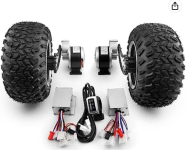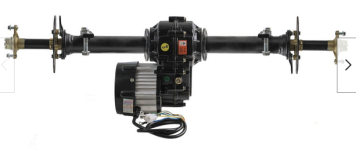It wasnt a pair of wheels; I tried but can't see how you can get that out of what I wrote:Wait when you said you cooked one pair of wheels because the unit wasn't operating fast enough and power supply was too much, then what wheel / type of hub motor did you switch to then? One still strong enough for operation, but at lower speed. Is there a name for the type of wheel you switched to for that particular project?
"In a bit more than a decade, I've only cooked two motors, of two different kinds in different projects. One of them was because it was meant to supply the power it was rated for at a much faster speed than I was running it at (which is the likely situation your project would be in with the motor wheels you've linked so far)." :?
The motor I cooked because of the winding vs speed vs load issue was a small Unite brushed motor out of some crappy scooter I probably got at goodwill, chain driving the rear 26" wheel of a regular bicycle. It had been designed to run a much smaller scooter wheel, perhaps 8", so using the same gear ratio and voltage driving a wheel over three times as large meant it was trying to spin at it's original speed, but was spinning instead only about 1/3 (or less) as fast at the same load. This meant the current flowing thru it was at least three times higher than it's designed for at that load because there wasnt' enough BEMF (you'll learn about that term when reading up on how motor windings work to get specific speeds, etc) to counter the incoming current (which there would have been if the motor had been wound for hte speed I was using it at under that load).
That project was abandoned and I went with a friction drive (which was still built wrong the same way but I used two motors and they coincidentally were bigger and more able to take it, but the mechanical design caused the motor shafts to snap from flexing stresses; the motors were radiator fan motors out of some car in a junkyard). So this one never had a chance to burn out.
Those were some of the very first things I tried to do with motors, and I knew probably less than you do at that point about motors, though I did know electronics fairly well already. I had no idea then why it failed, only that it did--it was years before I understood the failure. I looked around the internet and began reading up on this stuff, starting at the old V is for Voltage forums that got wiped out years ago and restarted, and then here on ES, where I've been learning ever since. If you want more details on the various experiments I've done you can read up on them at my old The Electricle™ : Bicycle Electric-Motor-Assist Project site (though I think google bought them and nuked all the pictures) and here on ES in my various threads https://endless-sphere.com/sphere/search/132343/ .
Then I built a frame to use powerchair motors chain driving the regular bike drivetrain, and those *were* matched to the speed / voltage / load, and other than (many) mechanical chain derailment issues from frame flex due to excessive torque loading, it worked fine.
After that I went to hubmotors in the wheels themselves, more or less wound for the speeds I was using them at, and have stuck with that ever since because it's easier to build, though has a lot of other issues it introduces that I wont go into here because they dont' apply to your usage (you can read up on the many hubmotor vs middrive posts and threads for those if you like).





